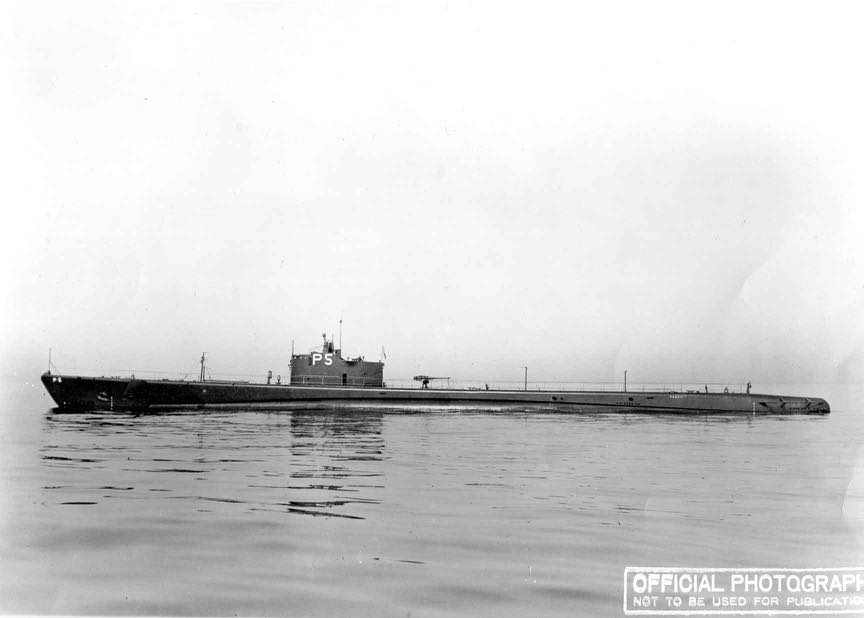Perch I SS-176

PPerch
I
(SS-176: dp. 1,330 (surf.), 1,997 (subm.); 1. 300'6"; b. 25'1";
dr. 13'10"; s. 19 k. (surf.), 9 k. (subm.); cpl. 50; a. 1 3", 6 21" tt.; cl. Porpoise)
The first Perch (SS-176) was laid down 25 February 1935 by the Electric Boat Co., Groton, Conn.; launched 9 May 1936; sponsored by Mrs. Thomas Withers; and commissioned 19 November 1936; Lt. Comdr. G. C. Crawford in command.
After shakedown in the North Atlantic, Perch became a member of the Pacific Fleet when she joined SubRon 6 in November 1937. The following spring she was engaged in the annual fleet problem and did some work on a survey of the Aleutian Islands, entering the Bering Sea 28 February. In the spring of 1939, Perch operated with the fleet on its cruise to the east coast.
In October 1939, Perch departed San Diego for Manila where she became a division flagship and made a summer cruise in 1940 to Tsinglao and Shanghai. She spent the year preceding the war in operations around the Philippines. A vveek before Japan attacked Pearl Harbor, Perch rendezvoused vvith two transports off Shanghai and escorted the 4th Marines from China to the Philippines.
The outbreak of hostilities found Perch in Cavite Navy Yard. She took part in the rush to clear the Navy Yard 10 December and watched, at close range, the destruction of Cavite by bombers. That night, Perch slipped through the Corregidor minefields and scouted between Luzon and Formosa, in search of targets. As hunting was poor, she shifted to an area off Hong Kong, and, on Christmas night, fired four torpedoes at a large merchantman, all missing. A few days later an eight thousand ton Japanese merchantman felt the sting of one of Perch's torpedoes. Enemy escorts prevented Perch from observing the kill, but expert evasion got her clear of the attackers' well placed depth charges.
Perch sailed south to Port Darwin, Australia, to repair damage, making several unsuccessful attacks enroute. She next made a patrol to Kendari on Celebes where she scouted the harbor and made several daring attempts to get through the narrow entrance to an attack position.
After a week of close contact with the enemy, obtaining valuable information, Perch headed south searching fot targets. In a night attack on a large merchantman off the eastern coast of Celebes, Perch was hit in the superstructure, forward of the pressure proof hull of the conning tower, by a high explosive projectile which blew away the bridge deck, punctured
the antenna trunk and temporarily put her radio out of eommission. Valiant efforts of her erew made repairs on deek at night in waters heavily patrolled by the enemy, and Perch headed for the Java Sea.
On the evening of l March l942, Perch surfaced thirty miles northwest of Soeraba]a, Java, N.E.I., and started in for an attack on the enemy convoy that was landing troops to the west of Soerabaia. Two enemy destroyers attacked and drove her down with a string of depth charges which caused her to bottom at 135 feet. Several more depth charge attacks caused extensive damage, putting the starboard motors out of eommission and causing extensive flooding throughout the boat. After repairs, Perch surfaced at two o'clock in the morning only to be again driven down by the enemy destroyers. The loss of oil, and air from damaged ballast tanks, convinced the enemy that Perch was breaking up and they went on to look for other kills, allowing Perch to surface.
With the submarine's decks awash and only one engine in commission, the erew made all possible repairs. During the early morning of 3 March, a test dive was made with almost fatal results. Expert handling and good luck enabled her to surface from that dive; only to be attacked by two enemy erulsers and three destroyers. When the enemy shells commeneed to straddle, the commanding officer ordered all hands on deck, and with all possible hull openings open, Perch made her last dive. She was struck from the Navy List 24 June 1942.
The entire erew was captured by a Japanese destroyer. Of the fifty-four men and five officers, only six, who died of malnutrition in Japanese prisoner-of-war camps, were unable to return to their country to enjoy the victory for which they had fought so valiantly.
Perch received one battle star for World War II service.
